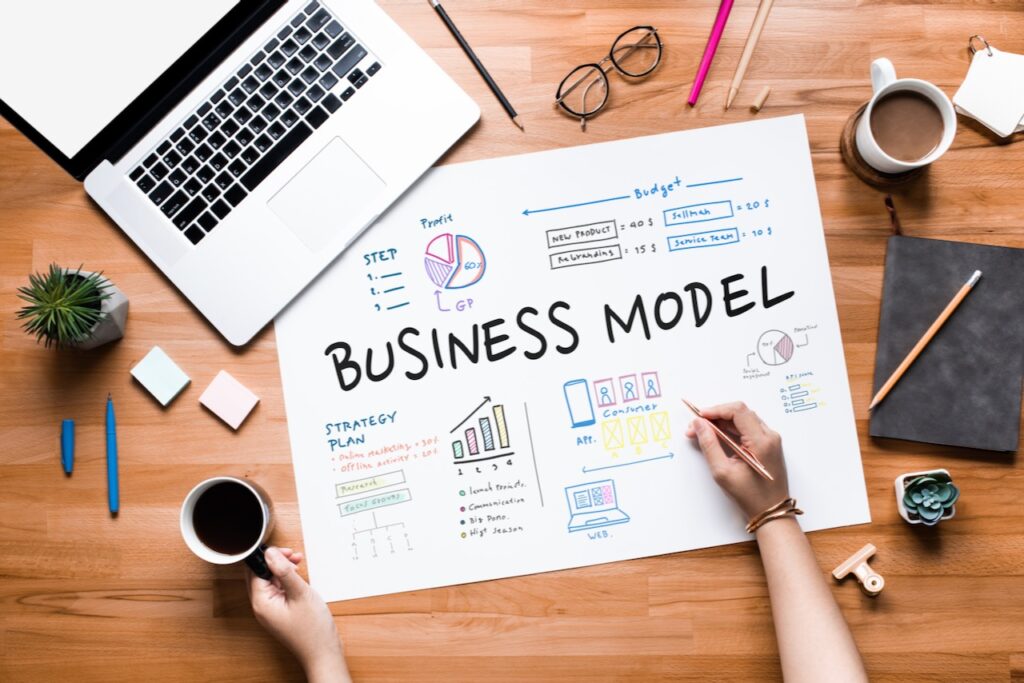
Regardless of whether it's a large company or a small start-up, every company needs a business model. All founders are therefore faced with the question: Which model fits my company best and can also be implemented well? There are various classic, but also digital business models to choose from. But what exactly is a business model, what are its benefits and how is it structured? We have all the answers for you.
The Business model (engl. Business Model) includes all the actions that take place within your company to create products, provide services and ultimately make profits from them. The model thus describes the processes by which your company earns money. And that makes it a crucial factor of your value creation.
You may be asking yourself, "But how is that different from corporate strategy?" You're actually wondering, and rightly so, because often the terms "business model" and "corporate strategy" are used interchangeably. Strictly speaking, however, this is wrong.
The business strategy is your plan to establish yourself in the market, win customers and generate sales. There are no points of contact with the business model. The business model merely describes which components within the company fulfill which functions. Thus, it primarily shows the logical interrelationships of all business activities.
Before you can decide on a business model, you first have to consider what precise customer problem you actually want to solve with your products or services. How can you operate profitably using this information? This is exactly the question you answer by choosing your business model.
In order to do this, you need to take a close and detailed look at your original business idea, which brings us to the first reason why such a model is important: you can better understand where exactly the success factors of your business are hidden, and where risks might be lurking.
While you are examining the individual business models, you also gather comprehensive information about which one offers the highest profitability. If you make the right choice, you can avoid unnecessary costs.
After you have analyzed all your business processes and chosen a model, you have created a wonderful basis for yourself to make optimizations. Thanks to your business model, you always have a comprehensive overview and recognize how you can strengthen your market position. All this makes the business model an indispensable building block on your way to competitiveness.

Every business model consists of four elements:
We'll take a close look at what all of them are about below.
What value do you create for your customers? This question is answered by the value proposition. Why exactly should potential customers show interest in your company? Of course, your products play an important role here. But what's behind them is even more important.
Do they make everyday life easier, do they give Joie de vivreDo they create moments of pleasure? That's exactly what your business model has to be designed for. For example, if you produce something that is supposed to make the lives of your customers easier, but make the purchasing process incredibly tedious, this would not correspond to the benefit that you promise. As you can see, the value proposition refers to the building blocks of the customer and the benefit. So both have to be defined precisely.
For a successful business model, you should be able to define your target group very precisely. Entrepreneurs like to talk about the market and its needs, but forget that behind them are real people with individual needs. They are the ones who buy something, not the market as an abstract construct.
Once you have defined your target group, you think about how you can make their lives easier with your products or services. You describe the customer benefits and complete the first element of the business model.
Now it's a matter of how you actually turn this customer benefit that you have set in your mind into reality. At this point, you first define your offer in concrete terms. What can your customers buy from you? And how do you produce it or make it available? What core skills do you and your team have that you can build on?
You may first have to invest some time to gain further knowledge and to expand your team and the knowledge available with it. But you also have the possibility to hand over all tasks that deviate from the core competencies of your team and yourself to external partners.
The next step is to design the distribution of your offer. Here, the right communication is the be-all and end-all. Only if you choose the right communication channel can potential customers find out about you and your offer.
Of course you want to make a profit with your company. But how exactly do you do that? Sure, by spending less than you earn. That's easy to say, but it requires intensive planning. So first of all, break down what specific costs are incurred.
How much do you pay for the rent of your company headquarters, how expensive are the materials you use, how much salary do your employees get and what do you spend on advertising? List these and all other expenses you incur. Mark amounts that are flexible and could be reduced if necessary.
Now you focus on how much revenue you're generating and can determine how much profit you'll ultimately make.
Why did you start your business? What drives you? What values do you stand for? All of this defines the fourth element: the entrepreneurial spirit. At the beginning of every company is the founder himself or herself and the values he or she represents. So what are those? A particularly customer-friendly approach? Sustainable production processes? A family-friendly way of working?
Based on your values, you create a team around you that fits exactly and also demonstrates the skills you need to lead your company to success. At this point, however, it's not just professional skills that are required. Also social skills should be an important role in your business model.
The list of business models you can choose from is long. How are you supposed to know which one is right for your company? The decision is anything but easy. To make things a little easier for you, we've taken a close look at five common business models and explain what they're all about!
Many companies sell their products through intermediaries. This is not the case with direct sales. The transactions take place directly between the company and the clientele and there is no one in between. This approach has its advantages, but also a few disadvantages.
At the top of the pro list is the larger profit margin. As an entrepreneur, you don't have to pay middlemen, so you get more of the pie. You can put these savings into production, benefit your team, or pass them on to your customers. If you choose the latter, you can offer lower prices or advertise more frequently with discount promotions and thus secure a competitive advantage.
If you decide to go direct, however, you will incur more costs elsewhere. For example, you now need your own online store, which must be operated and maintained. Of course, this does not happen for free.
You could already win customers for yourself and sell something? Great, congratulations! At best, they'll buy more products from you right now. So you make product suggestions to draw their attention to other items that they might also be interested in, based on their previous purchases or the goods they last looked at. This is known as cross-selling.
There doesn't always have to be a direct link to articles that your customers have been interested in so far. Feel free to refer them to products they don't yet know or haven't yet felt attracted to, and inspire them.
What used to be for newspapers and magazines now exists in almost every industry: subscriptions. From electrical appliances to hygiene products to groceries. The subscription business model ensures that you are always well supplied with everything you need. How convenient is that? That's exactly what you can offer your customers.
At regular intervals, which they select beforehand, they receive their goods without having to do anything in return. This makes their everyday life much easier. Of course, you as an entrepreneur also benefit from this, because with subscriptions you can ensure that your customers keep receiving your products. The results are closer and more long-term customer loyalty and predictable sales.
A license is more or less a permission to use a certain product. You don't put it directly into the hands of your customers, but simply grant them the right to use it. This business model is particularly suitable for companies that develop software or apps, or for publishing houses that grant paying customers online access to publications.
A license usually runs for a predetermined period of time. Once this period is over, a new payment is due if your customers want to continue to have access to your product.
You've probably come across the term "franchising" before in relation to restaurants or stores. A franchisor, who owns a brand or certain products, grants franchisees the right to use them in return for payments.
As a franchisor, you allow others to use the name of your company and sell your goods or services. This allows you to increase your company's name recognition enormously without having to contribute much yourself. Your franchisors, on the other hand, benefit from an easier start to self-employment.
Digitization is constantly opening new doors for us in almost all areas of life, transforming the old into more modern, more convenient versions. Of course, these transformations don't stop at business models. There are now numerous digital models that open up completely new possibilities for you.
Probably the most important business model that digitization has spawned is e-commerce. It enables you to sell, advertise and contact customers via digital channels. The most typical example of e-commerce is the classic online store. It breaks down spatial and temporal barriers because it enables shopping anywhere at any time. Companies that do not have an online store are therefore accepting an enormous competitive disadvantage.
If you choose the e-commerce business model, you can also reduce your costs. You save on rent and personnel costs and increase your income thanks to end consumers who enjoy the simple and flexible shopping option.
Its own Business is not an easy task. Basically, only two points are crucial: your entrepreneurial spirit and your steadfastness. If you stay on the ball, show willpower and take things into your own hands, all doors will be open to you. To avoid making your path to success unnecessarily difficult, choose a business model that fits your company and your plans. With a large portion of self-activity and the right business coaching skills, nothing more stands in your way.

